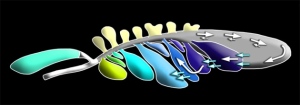Whilst being old (last week’s) news, the discovery of unidirectional airflow in monitor lizards is:
- Really cool.
- Really important.
- Allows TDS to explain some key methods/principals used by palaeontologists.
Before we get bogged down in phylogentic-y goodness, let me introduce unidirectional airflow. As humans (and mammals more generally) we suck at breathing. Compared to birds, our respiratory system is pretty inefficient, but that’s fine, we’re not running around at full speed all day. Our breathing system is called tidal breathing, and involves the mixing of ‘new’ air and ‘old air’ in the lungs. This means that there’s not a huge amount of ‘fresh’ air in our lungs, meaning, compared to birds (and the like, more on that later) less oxygen enters the bloodstream per respiratory cycle. However birds have employ a neat trick called unidirectional airflow. Essentially, they’ve got a few more respiratory chambers which allows oxygen to enter the bloodstream during both inhalation and exhalation (by virtue of being a one-way system). This means a birds respiratory system are relatively efficient, which is great for them, as flying’s seriously hard work.
Up until 2010, unidirectional airflow was only thought to exist in birds. But it has also been found in crocs (Farmer et al. 2010). So another scaly thing with a more efficienty respiratory system than us, big whoop. Yes actually, because with the help of Extant Phylogenetic Bracketing (EPB) we can learn a lot more about the success of diapsids (fancy name for the group containing all the birds, crocs, lizards, tuataras and oh, dinosaurs) during the Mesozoic.
Extant Phylogenetic Bracketing is essentially using common sense to infer anatomy and behaviour in extinct organisms. For something so widely used today, it’s only really been applied in palaeontology since 1995 (Witmer 1995). At it’s core we use our knowledge of what anatomical features (and possibly behaviour) modern organisms have, and put them into an evolutionary context to infer what features their common ancestors might have had. Birds, crocodiles and lizards are an excellent example of how palaeontologists have mastered EPB. So to use UA as an example, if we know birds have it, as do crocs, we can infer that dinosaurs may have had a UA respiratory system, because the last common ancestor of birds, dinosaurs and crocodiles (point A on the diagram below) may have had UA.

Very abridged (i.e no pterosaurs, sorry) of the diapsid tree (excluding Mesozoic marine reptiles). A is the last common ancestor of crocs and birds, B is the origin of birds, crocs, dinosaurs and lizards.
Cool story bro, but what about monitor lizards? Ok, so using EPB we’ve inferred that dinosaurs have UA due to their extant relatives both having UA. So if we now factor monitor lizards into the equation, we can now infer that the last common ancestor of birds, dinosaurs, crocs and lizards (i.e diapsids, point B on the diagram above) probably used unidirectional airflow as a respiratory strategy. This means that UA (originally thought to be unique to birds) originated 100 million years before birds evolved. But that’s not all.

Just another scaly thing with a more efficient respiratory system than us. All hail the savannah monitor lizard.
Lizards and Birds (and to a certain degree, crocs) are hugely successful organisms. A more efficient respiratory system has certainly aided in their almost global (niche) domination. This may explain why diapsids (dinosaurs in particular) were so diverse and successful during the Mesozoic (and also perhaps why they were so bloody big). So it looks like savannah monitor lizards are a…breath of fresh air.
References
Farmer, C. G. and Sanders, K. (2010). Unidirectional Airflow in the Lungs of Alligators. Science 327, 338–340.
Witmer, L. M. (1995). “The extant phylogenetic bracket and the importance of reconstructing soft tissues in fossils”, in Functional morphology in vertebrate paleontology (ed. J. J. Thomason), pp. 19–33. Cambridge University Press
Schachner, E. R. et al. (2013). Unidirectional pulmonary airflow patters in the savannah monitor lizard. Nature http://dx.doi.org/10.1038/nature12871

